Abstract
The N-phenylquinoneimine scaffold is a versatile synthetic platform that has gained significant attention in the field of drug discovery due to its structural diversity and capacity to interact with biologically relevant targets. This review explores established synthetic methodologies and highlights the significant biological activities exhibited by compounds derived from this scaffold, their implications for medicinal chemistry, and the development of novel therapeutics.
1. Introduction
Diversity-orientated synthesis (DOS) continues to grow as an area of importance in the disciplines of organic synthesis and chemical biology [1,2,3]. One important area that should benefit significantly from DOS is drug discovery. The existing chemical space can be expanded with new synthetic molecules, with the hope of identifying novel and better drug and probe molecules [4]. Arguably, one of the most promising synthetic strategies for generating collections of new compounds with increased molecular complexity and diversity via DOS involves the sequencing of multicomponent reactions with subsequent transformations, including cyclisations, couplings, and refunctionalisations [5].
DOS requires a planning algorithm to deliver an efficient but divergent route. Although DOS aims to achieve a diverse and non-focused coverage of biologically active chemical space, the results of DOS may find use in other fields in future years. Complexity-generating reactions are again important for efficiency (multicomponent-coupling, cascade and tandem complexity-generating reactions are the most valuable); however, pathways need to be identified that give structurally diverse targets. In order to achieve the highest levels of structural diversity, (i) the building blocks, (ii) the stereochemistry, (iii) the functional groups and, most importantly, (iv) the molecular framework must be varied. The key to the structural complexity is the complexity-generating reactions, while the key to the structural diversity comprises the branch points and building blocks [3]. The identification in the forward direction of pairwise relationships, where the product of one complexity-generating reaction is the substrate for another, can lead to high levels of molecular complexity in a very efficient manner [2].
1.1. N-Phenylquinoneimine and Its Pharmacological Significance
N-Phenylquinoneimine (NPQ 1, Figure 1), due to its α,β-keto and α,β-imino functionalities, is highly reactive and offers great potential for regioselective reactions. NPQs are highly coloured compounds [6,7,8] and constitute a core structure in several important natural products, Refs. [9,10], some of which are key abiotic and biological compounds, which intercalate with DNA [11]. New avenues for molecular sensors [12] and ligands, Refs. [13,14] for drug delivery [15,16] and controlled material growth have been provided through many of these hybrid materials. NPQs can be used as building blocks to access useful synthetic compounds that can serve as potential key intermediates in cascade reactions [17]. Since many natural products and druglike compounds include heterocyclic subunits, the ability to synthesise efficiently diverse heterocyclic compounds is critical. NPQs can be used to access aromatic heterocyclic structures largely used as scaffolds for generating combinatorial libraries in drug-discovery research [18]. Sulfones that can be synthesised from multistep reactions of NPQs are found in many medicines and drug candidates under development for the treatment of a host of diseases impacting human health worldwide [19]. NPQs represent a new frontier for the design and generation of molecular diversity and complexity [20,21].
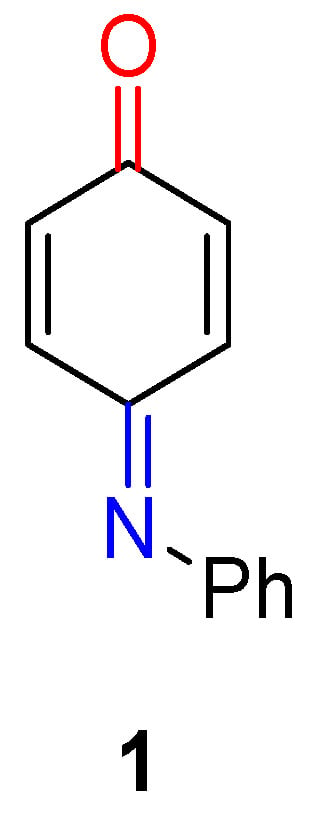
Figure 1.
Structure of N-phenylquinoneimine 1 (NPQ).
1.2. Quinoneimines in Natural Products and Dyes
Natural products and their structural analogues have historically made a major contribution to pharmacotherapy, especially for cancer and infectious diseases [22,23], but also in other therapeutic areas, including cardiovascular diseases and multiple sclerosis [24,25,26]. Natural products are characterised by enormous scaffold diversity and structural complexity [27].
Quinoneimines are highly coloured dyes [6,7,8,28,29] and constitute a core structure in several important natural products [9,10,30,31,32,33,34]. Some of these quinoneimines have been reported as growth-promoting substances with a low molecular weight, isolated from microorganisms [20]. Exfoliazone, Questiomycin A, N-Acetylquestiomycin A, and Acetylmichigazone have been isolated from Streptomyces exfoliates BT-38 [9,10], and Venezuelines A–G from Streptomyces venezuelae [30]. Chandrananimycins A–C were isolated from the culture broth of a marine Actinomadura sp. Isolate M045. They contain the phenoxazin-3-one chromophore, which is part of complex natural products like actinomycin, aurantin, and cryptomycin and is responsible for their colour [31]. Chandrananimycin D, pitucamycin, grixazone B, and benzerramycin A–C have been reported from a Streptomyces griseus strain isolated from an old building with moisture damage [32,33]. Cinnabarin and Cinnabarinic acid have been isolated as fungal pigments [34] (Figure 2).
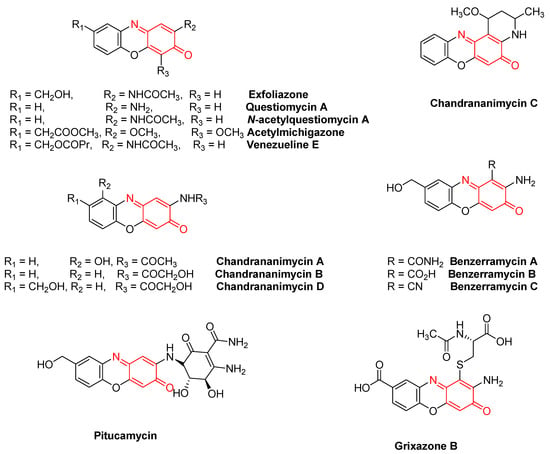
Figure 2.
Some of the representative examples of quinoneimines in natural products.
Quinoneimine dyes are based on the structure of the fictional compound para-quinone-di-imine 2, from which the name of the dye class originates. There are several subgroups of quinoneimine dyes, such as the azines 3, the oxazines 4, and the thiazines 5 (Figure 3).

Figure 3.
Some subgroups of quinoneimine dyes.
Quinoneimine dyes are commonly used in colour photography and in the production of pencils, as well as for dyeing paper and fur. In addition, they are used as chemical indicators [35].
Some commonly used and important quinoneimine dyes are neutral red, safranin O, Nile blue, Nile red, Meldola’s blue, gallocyanin, gallamine blue, celestine blue B, and the methylene blue homologues (Figure 4).
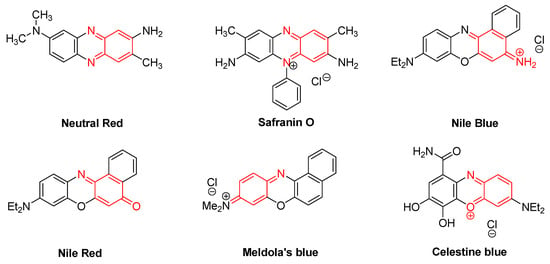
Figure 4.
Some of the common quinoneimine dyes.
In microbiology, neutral red is used in the MacConkey agar to differentiate bacteria for lactose fermentation [36]. It also acts as a pH indicator, changing from red to yellow between pH 6.8 and 8.0.
Safranin is the classic counterstain in both Gram stains and endospore stains. It is also used as redox indicator in analytical chemistry.
Nile blue and Nile red are fluorescent dyes [37]. They have reasonably high fluorescence quantum yields in nonpolar solvents and they fluoresce at reasonably long wavelengths [38].
Meldola’s blue dye is used mainly as a pigment in textiles, paper, and paints. It has also been used in electrochemical experiments involving DNA, wherein the dye mediates electron transport [39].
Celestine blue dye is used with iron-aluminium complexes as a substitute for haematoxylin in H–E (haematoxylin–eosin) staining because of its resistance to low-pH solutions. It has been used as a new electroactive indicator in DNA biosensors and is also applicable to HOCl detection in living cells and to assaying the chlorinating activity of myeloperoxidase [40].
1.3. Biological Activity of N-Phenylquinoneimine Scaffolds
Quinoneimines are key abiotic and biological components that intercalate with DNA [11]. Quinoneimines and diimines are of interest in chemistry, and the former moieties have been proposed as intermediates in a number of biological processes [41]. Their diverse biological activities and synthetic applications have attracted the synthetic community to synthesise these important alkaloids [42,43,44,45]. Imai S. et al. [10] have reported exfoliazone (Figure 2), a phenoxazine antibiotic showing antifungal activity against V. ceratosperma. Pitucamycin and Chandrananimycin D have been found to exhibit antiproliferative activities against a number of cell lines and only a weak cytotoxicity [33].
Chandrananimycins A–C (Figure 2), isolated from Actinomadura sp. Isolate M048, have been reported to have high biological activity against Staphylococus aureus, Bacillus subtilis, and Streptomyces viridochromogenes [31]. They have also exhibited antialgal activity against the microalgae Chlorella vulgaris, Chlorella sorokiniana, and Scenedesmus suspicatus and antifungal activity against Mucor miehei and Candida albicans. Compounds such as Chandrananimycins A–C, containing the phenoxazine-3-one chromophore, are frequently encountered as metabolites of microorganisms. They are yellow-to-orange-coloured compounds and exhibit antibacterial [46], antifungal [10], phytotoxic [47], and anticancer activities. In addition, some are also known to show potent cell-growth-stimulating activity [9]. Due to their DNA intercalation, these complex phenoxazinone derivatives have shown pronounced antimicrobial [48], antitumor [49], and anticancer potency [50], with some of them also exhibiting anticoccidial activity [51]. Table 1 summarises the quinoneimine derivatives occurring as natural products and their biological activities.

Table 1.
Naturally occurring quinoneimines and their biological activities.
1.4. Significance of Quinoneimine-Based Drugs
Exfoliazone (Figure 2) is an antibiotic that is active against Valsa ceratosperma, the causative fungus of the apple canker disease [10].
The actinomycins are a family of chromopeptide antitumor antibiotics isolated from various Streptomyces strains [50]. Actinomycins C3 and D have found clinical application as anticancer drugs, particularly in therapy for Wilm’s tumor [52] and soft tissue sarcomas [53] in children, and are still of interest in molecular biology [50].
Actinomycin D (Figure 5) has also been proposed as a therapeutic agent for AIDS, because of its potency as an inhibitor of HIV-1 minus-strand transfer [54]. It is a chemotherapy medication used to treat a number of types of cancer. This includes rhabdomyosarcoma, Ewing’s sarcoma, trophoblastic neoplasm, testicular cancer, and certain types of ovarian cancer [55].

Figure 5.
Structure of Actinomycin D.
Some chemicals and drugs have been reported to form reactive quinone and quinoneimine metabolites [56]. Quinoneimines are found as highly redox-active molecules and electrophiles, with both properties being crucial for their reactivity in biological systems. They are highly reactive organic chemicals and comprise a class of toxicological intermediates [57,58] that interact alone by generating reactive oxygen species (ROS) in biological systems to promote inflammatory reactions and reactive immune cells, oxidise DNA, and induce toxicity. They can be responsible for effects in vivo, including immunotoxicity, cytotoxicity, and carcinogenesis [57]. Quinoneimines reduce the oxygen to reactive oxygen species, acting as prooxidants, and, as electrophiles, they form covalent bonds with tissue nucleophiles.
Important drug molecules that lead to the formation of quinoneimine reactive metabolites include Lumiracoxib (non-steroidal anti-inflammatory), Diclofenac (non-steroidal anti-inflammatory), Paracetamol (antipyretic), Amodiaquine (antimalarial), Gefitinib (kinase inhibitor), and Eriotinib (kinase inhibitor) (Figure 6).

Figure 6.
Some drugs that form quinoneimine reactive metabolites [56].
Paracetamol is widely used as an over-the-counter remedy to treat fever and pain. N-acetyl-p-aminophenol (APAP), the active ingredient in Paracetamol, is metabolised via 3 pathways: glucuronidation, sulfation, and glutathione conjugation. Glucuronidation and sulfation produce nontoxic metabolites for excretion. N-acetyl-p-benzoquinoneimine (NAPQI) is a toxic intermediate produced via cytochrome P450 2E1 (CYP 2E1; the main metabolising agent) and cytochrome P450 3A4 (CYP3A4) metabolism. NAPQI is then conjugated by glutathione (GSH) to form a nontoxic metabolite for excretion (Scheme 1) [56].
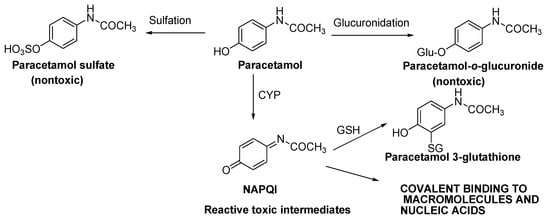
Scheme 1.
Paracetamol bioactivation to reactive species (quinoneimine) [56].
1.5. Synthesis of Quinoneimines
The common method of preparing N-phenylquinoneimines is through the oxidation of the corresponding hydroxydiphenylamine by using various oxidising agents (Table 2).

Table 2.
Various oxidising agents used in the preparation of quinoneimines.
Other oxidising agents used include iodoxybenzene and iodosylbenzene [68,69]. The use of Ag2CO3 on Celite for the oxidation of 4-hydroxydiphenylamine 6 is shown in Scheme 2. The Ag2CO3 adsorbed onto Celite, also known as Fétizon’s reagent, is a solid-supported oxidising agent (and so is easily removed after the reaction); it provides the iminoquinones in an excellent yield and is preferred to other methods [60,70]. The method uses two equivalents of Ag2CO3 and, at room temperature, 99% conversion to product 1 is observed in 24 h.

Scheme 2.
Preparation of N-phenylquinoneimine 1 [60].
Most of these methods have disadvantages, such as the use of solvents and toxic reagents, a robust play environment, and low efficiency due to polymerisation, hydrolysis, and dimerisation. Electrochemical methods, on the other hand, are known as suitable, moderate, economical, fast, and easy methods that have been used for the synthesis of new quinoneimine derivatives [71].
2. Molecular Diversity from N-Phenylquinoneimine
Molecular diversity refers to the variety of different molecules that make up living organisms and their interactions with each other. This diversity is essential for life, as it enables organisms to carry out a range of biological functions, such as metabolism, growth, and reproduction. One aspect of molecular diversity that refers to the variety of chemical structures and properties of molecules is chemical diversity. Chemical diversity is important for drug discovery and development, as different molecules can have different effects on biological systems. Natural products, such as those derived from plants and microorganisms, are a rich source of chemical diversity and have been used for centuries in traditional medicine.
The best, but most difficult, strategy for chemical diversity is to make compounds in a way that anticipates problems at each step of the drug-discovery process in which organic synthesis is involved. The first such step involves finding a molecule that modulates a disease target or process; this requires thousands of structurally diverse compounds to be produced for screening. The next step is to optimise the biological properties of the compounds found during screening. This involves making analogues of the compounds, each containing slightly different structural modifications—ideally, every atom in the compound should be modified, without an overwhelming synthetic effort. The final step involves synthesising the optimal compound, either for use as a biochemical probe for research or as a drug in medicine, efficiently, at low cost and in large quantities [72].
Scheme 3 [21] shows some reactions of N-Phenylquinoneimine that can lead to structural complexity and molecular diversity.
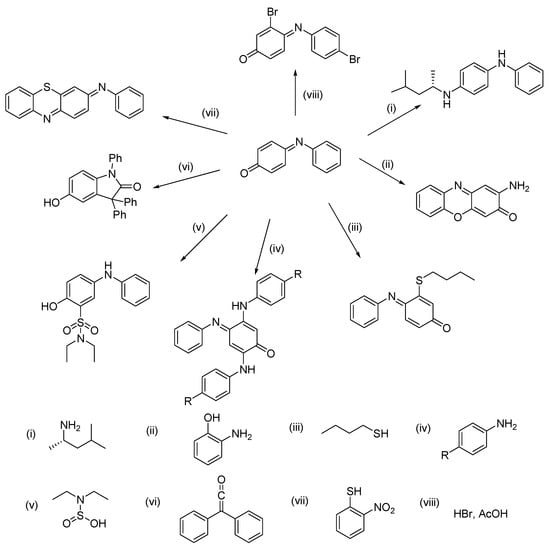
Scheme 3.
Reactions of N-Phenylquinoneimine leading to structural complexity [21].
2.1. Nucleophilic Addition Reactions of N-Phenylquinoneimine
2.1.1. Direct Addition
NPQ 1 can react with nucleophiles via 1,2-addition or 1,4-addition. NPQ has two unique sites susceptible to 1,2-addition: the ketone and the imine. If the nucleophile is an amine, for example, RNH2, then attack at the carbonyl carbon followed by reduction gives 1,4-diaminoarenes 8, whilst attack at the imino carbon converts the N-phenyl group to a new group 7 (Scheme 4).

Scheme 4.
Nucleophilic attack via 1,2-addition to the ketone or the imine.
2.1.2. Conjugate Addition
There are two possible α,β-unsaturated systems in NPQ chemistry: α,β-keto and α,β-imino. All four β-carbons are unique and have different reactivities. Scheme 5 shows the products of the attack of a nucleophile at all four sites susceptible to 1,4-addition. By quenching the enolate with an electrophile other than H+, it may be possible to selectively add two substituents to the ring in a single reaction. The stereochemistry of the N-arylamine also introduces asymmetry. Attack on the α,β-ketone generates products 9 and 10, whilst attack on the α,β-imine generates products 11 and 12 (Scheme 5).
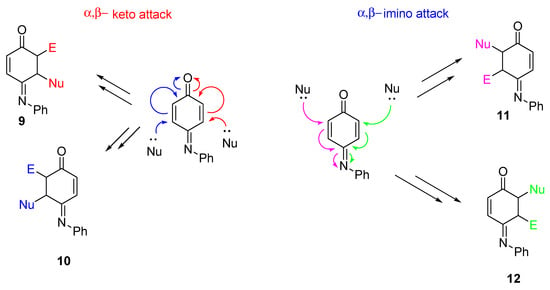
Scheme 5.
Nucleophilic attack via 1,4-conjugate addition.
2.2. Reaction with Nitrogen Nucleophiles
2.2.1. Aliphatic Amines
The addition of primary aliphatic amines 13 to NPQ 1 has been reported by Cottman [66,73] as a method of preparing N-substituted phenylenediamines. The reaction proceeds via a 1,2-addition to the carbonyl group, which, on reduction, gives 1,4-diaminoarenes (Scheme 6). The reaction between NPQ and primary amines may be in the presence of, or absence of, an acid catalyst. The N-phenyl-N′-diimines compound 14 was reduced to the N-substituted phenylenediamines 15 using aqueous sodium hydrosulfite. Representative catalysts for the hydrogenation reaction are platinum on carbon, palladium on carbon, and aqueous sodium hydrosulfite [66]. The amines that have been reported for the reaction includes methylamine, octylamine, 1,3-dimethylbutylamine, and cyclohexylamine. These N-substituted phenylenediamines have utility as anti-degradants in rubber, polymer stabilisers, dye intermediate, pharmaceuticals, and photographic chemicals [74,75].
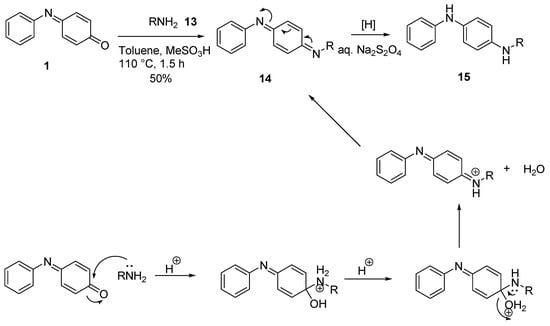
Scheme 6.
Addition of aliphatic amine to NPQ [21,66].
2.2.2. Aromatic Amines
The reactions of aromatic amines 16 with NPQ proceed through a 1,4-conjugate addition to the α,β-unsaturated ketone, yielding intermediate 17 (Scheme 7). This intermediate is then reacted with another equivalent of NPQ at the α,β-unsaturated imine site, resulting in intermediate 18. Subsequent oxidation reactions lead to the formation of the desired diarylamino products 19, as depicted in Scheme 7 [21]. The decrease in the oxidation potential of the quinoneimine, NPQ, is attributed to the introduction of electron-donor arylamino substituents. Consequently, the starting quinoneimine, NPQ, acts as an oxidising agent, as evidenced by the formation of p-hydroxydiphenylamine 19 [76].
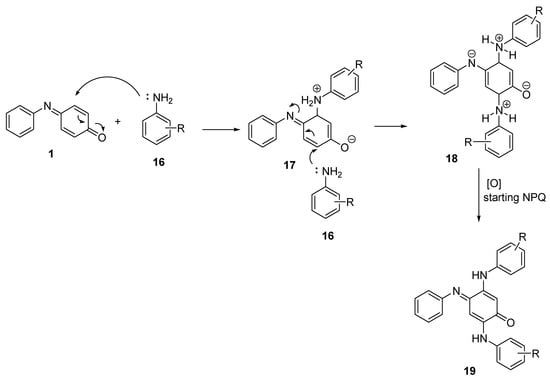
Scheme 7.
The reaction mechanism of the 1,4-conjugate addition of aromatic amines to the α,β-unsaturated ketone and α,β-unsaturated imine of NPQ [21,76].
The reaction has been reported by Tsoi E. V. et al. [76] Electron-withdrawing and electron-donating anilines have been used, giving good yields (Scheme 8). Aromatic amines react with NPQ, forming diarylamino products 19, which, when heated under oxidative conditions (using potassium ferricyanide), are converted to products of intramolecular oxidative cyclisation [76], phenazinones 21 through 5,10-dihydrophenazine derivatives 20 (Scheme 8).
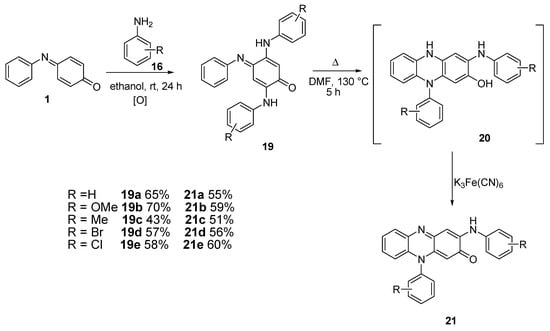
Scheme 8.
Reaction of aromatic amines with NPQ and subsequent oxidation to phenazinones [76].
The cyclisation of substituted quinone imines and diazabutadiene derivatives of aminophenols afforded phenoxazine and benzoxazine derivatives, which were finally transformed into fused heterocyces [77].
2.3. Reaction with Sulfur Nucleophiles
NPQ reacts with sulfur nucleophiles, such as thiols [78], thiophenols [79], and sulfinates [80], via nucleophilic addition.
2.3.1. Thiols
The nucleophilic addition of alkane- and arenethiols to NPQ occurs at the α,β-unsaturated imine and the α,β-unsaturated ketone [78]. The reaction with alkane thiols 22 was conducted in ethanol at room temperature, giving the products of the hydroxydiphenylamines, which are then oxidised using mercuric oxide to the corresponding alkylthio- quinonimines 23. The reaction with arenethiols 24, however, was carried out in benzene and refluxed; the alternative addition products 25, 26, 27, and 28 were observed (Scheme 9). The difference in these reactions is attributed to the solvent effect of the polar protic solvent (ethanol) versus a nonpolar solvent (benzene). The reaction of N-Phenyl-1,4-benzoquinonemono imine benzoanalogs with alkanethiols was found to give similar 1,4-addition products [81].
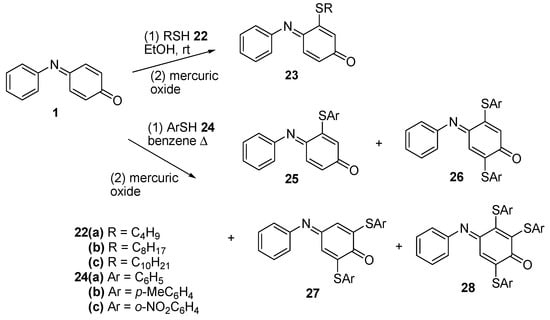
Scheme 9.
Reactions of thiols with NPQ [78].
With a change in the reaction conditions (0 °C in benzene), the 6-monosubstituted derivatives 29 was formed (Scheme 10).

Scheme 10.
Alternative mode of addition of thiols to NPQ.
2.3.2. Sulfinates
The reaction of NPQ derivatives with sodium arenesulfinates 30 has been reported by Konovalova et al. [80]. The reactions were carried out in acetic acid at 70 °C using two equivalents of the nucleophile; however, the reactions afforded, exclusively, the product of single 1,4-addition to the α,β-unsaturated imine system 31. This was then oxidised with lead (IV) acetate to the corresponding 1,4-benzoquinone imine derivatives 32 (Scheme 11). This method provides an alternative route to making this type of sulfone.

Scheme 11.
Addition of sodium arenesulfinates to NPQ derivatives [80].
Some polymers containing sulfone groups are useful engineering plastics, as they exhibit high strength and resistance to oxidation, corrosion, high temperatures, and creep under stress; for example, some are valuable as replacements for copper in domestic hot-water plumbing [82]. Precursors to such polymers are the sulfones bisphenol S 33 and 4,4′-dichlorodiphenyl sulfone 34 (Figure 7). Examples of sulfones in pharmacology include dapsone 35, a drug formerly used as an antibiotic to treat leprosy. Several of its derivatives, such as promin, have similarly been studied or applied in medicine [83].

Figure 7.
Some useful sulfone-containing compounds.
2.4. Reaction with Halogens
Initial studies on the reaction of hydrobromic acid with NPQ have been reported by Burmistrov et al. [84]. It was reported that the nucleophilic addition of bromide was to the α,β-unsaturated ketone, giving compound 36 (Scheme 12). Aqueous hydrobromic acid was added to NPQ in acetic acid at room temperature, and organic extracts from the reaction mixture were treated with lead (IV) acetate to convert the phenol intermediate to the quinoneimine system. Bromination of the phenyl ring at the para position was also found to occur as a competing process, giving the di-substituted compound 37. The addition of resorcinol to the reaction of NPQ with hydrobromic acid clearly changed the composition of the reaction mixture, eliminating the bromination of the phenyl group and giving the mono-substituted product 36 only.

Scheme 12.
Reaction of HBr with NPQ [84].
The reaction of hydrochloric acid with NPQ was conducted in the same manner and reportedly gave the mono-substituted compound 38. However, the chlorination of the phenyl group was not observed (Scheme 13) [85].

Scheme 13.
Addition of hydrochloric acid to NPQ [85].
2.5. Reaction with Carbon Nucleophiles
2.5.1. Enolates
The reaction of NPQ with dimedone 39 has been reported by Novikov V. P. et al. [86]. The condensation reaction was carried out by boiling the quinoneimine, dimedone, and anhydrous zinc chloride in propanol for 10 min. The reaction mixture was worked up with water after cooling for 12 h at room temperature. The resulting product was filtered and washed, giving a yield of 58% of compound 40 (Scheme 14).

Scheme 14.
Reaction of NPQ with dimedone [86].
2.5.2. Organometallic Reagents
The reaction of NPQ with organometallic reagents gave the products of 1,4-addition 41, 1,6-addition 42, and reduction 43 (Scheme 15) [87].

Scheme 15.
The reaction of NPQ with organometallic reagents [87].
The course of the reactions with the organometallic reagents used is shown in Table 3 below.

Table 3.
Reaction of NPQ with organometallic compounds at −60 °C.
3. Oxidation of N-Phenylquinoneimine
The oxidation of NPQ using meta-Chloroperoxybenzoic acid in DCM at room temperature yielded the N-phenylquinoneimine N-Oxide 44 (Scheme 16) [88].

Scheme 16.
Oxidation of NPQ.
The presence of an electron-withdrawing group should cause a change in the chemical shifts in the 1H NMR spectrum of NPQ N-oxide when compared to NPQ. The largest differences will be for protons closest to the nitrogen, as expected when considering their proximity to the N-oxide. A relatively smaller downshift in the peaks for the other protons, which are farther away from the oxygen of the N-oxide, should, therefore, be expected.
3.1. Cycloaddition Reactions
The addition of diphenylketene 45 to NPQ in ether, as reported by Bird C. W. [89], resulted in the formation of a cycloaddition product, β-lactam 46, which rearranged to give the oxindole 47 (Scheme 17). The oxindole can be readily converted into the methyl ether via dimethyl sulphate and methanolic sodium hydroxide.

Scheme 17.
Cycloaddition reaction of NPQ with diphenylketene.
3.2. Coupling Reactions
Some palladium-catalysed coupling reactions of NPQ have been investigated using the monosubstituted bromo-NPQ 36. [21] The Suzuki, Stille, Kumada, and Buchwald–Hartwig reactions of NPQ are discussed below; others include carbonylation [90] and redox-neutral C-N coupling reactions [91].
3.2.1. Suzuki Coupling
The reaction of 3-bromo NPQ 36 with a range of arylboronic acids gave the coupled products 49 in average-to-good yields, with the biaryl products 50 obtained as by-products resulting from the homocoupling of the arylboronic acid (Scheme 18) [21]. A much lower yield was observed when electron-deficient boronic acids were used, and the equivalent of arylboronic acid used was found to be insignificant to the yield of the coupled product.
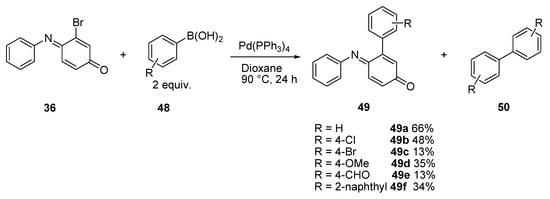
Scheme 18.
Suzuki reaction of compound 36 with arylboronic acids.
3.2.2. Stille Coupling
The reaction of 3-bromo NPQ 36 with tributyl(phenyl)stannane 51a was carried out using one equivalent of the arylstannane in THF, with LiCl as the base, and heated at 100 °C for 24 h [92]; both the coupled product and biaryl product were obtained in low yields. The reaction was repeated with the base changed to Ag2CO3 and the solvent to dioxane, and an increase in yield was observed for the coupled product 52, while the biaryl product was not formed (Scheme 19). This demonstrates that the solvent/base combination is critical in the optimisation of the palladium-catalysed Stille reaction. The reaction with tributyl(thiophen-2-yl)stannane 51b was, therefore, only carried out using Ag2CO3 in dioxane, and the coupled product was obtained at a good yield, while the biaryl product was not formed. This selectivity could also result from the use of one equivalent of the arylstannane, since the reaction of a Pd(II) precatalyst with two equivalents of the arylstannane mostly accounts for the homocoupling side-products [93].

Scheme 19.
Stille reaction of compound 36 with arylstannanes [21,92].
3.2.3. Kumada Coupling
The reaction of 3-bromo NPQ 36 with isopropylmagnesium chloride 53 was conducted in THF at 60 °C for 2 h (Scheme 20) [94]. The crude reaction mixture was purified via chromatography (SiO2 1:4 ethylacetate–petrol) to give the coupled product 54 as a red oil. The Kumada coupling, although only giving a low yield of the product, is important and different from the other coupling reactions investigated, as it allows the introduction of alkyl as well as aryl groups.

Scheme 20.
Reaction of 3-bromo NPQ with isopropylmagnesium chloride [21,91].
The lack of reactivity and low yields observed in some of the palladium-catalysed coupling reactions considered may result from the oxidation of Pd(0) to Pd(II) by the bromo NPQ in the oxidative addition step of the catalytic cycle, since it also acts as an oxidising agent.
3.2.4. Buchwald–Hartwig Coupling
The Buchwald–Hartwig amination reaction was investigated by coupling 3-bromo NPQ with arylamines as a means of forming new C–N bonds (Scheme 21) [21].
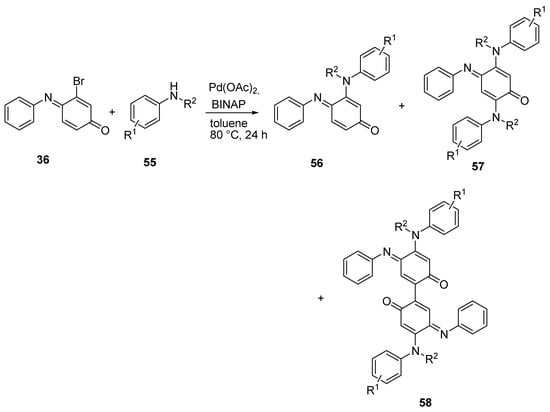
Scheme 21.
Reaction of 3-bromoNPQ with aniline derivatives [21].
The reaction, which may also occur via addition to the α,β-unsaturated ketone, gives the expected coupled product 56 in good yields, as shown in Table 4. The anilines with electron-deficient groups (entries 3 and 4) were observed to give lower yields. The product of diaddition to the α,β-unsaturated ketone and α,β-unsaturated imine, 57 was also observed. A product of dimerisation was observed with entries 5 and 6, giving compound 58 as a by-product resulting from oxidative coupling between two molecules.

Table 4.
Reaction of 3-bromo NPQ with aniline derivatives.
The formation of the dimerised product 58 is not surprising, as it has been reported that unexpected observations, new transformations, or unusual side reactions often occur in Pd-catalysed reactions, and these stem from poor catalytic turnover, unusual reactivity or selectivity, or the presence of unwanted side-products [93].
4. Conclusions
Overall, N-phenylquinoneimine-based compounds have emerged as a powerful probe for scientists in drug discovery and medicinal chemistry. Significant advances have been evidenced in their natural product chemistry, copolymerisation [95], and coupling reactions. This novel class of quinoneimine derivatives shows promising antibacterial, antimicrobial, anticancer, anti-inflammatory, antioxidant, and other therapeutic activities that position them as versatile potential drug candidates for interventions in various disease areas and for use as building blocks to access new synthetic molecules.
Author Contributions
Conceptualization, A.A. and R.S.; Writing—Original Draft Preparation, A.A.; Writing—Review & Editing, A.A. and R.S.; Visualization, A.A. and R.S.; Supervision, R.S.; Funding Acquisition, R.S. All authors have read and agreed to the published version of the manuscript.
Funding
This research received no external funding.
Institutional Review Board Statement
Not applicable.
Informed Consent Statement
Not applicable.
Data Availability Statement
The data presented in this study are available in article.
Acknowledgments
The authors express their appreciation for the research environment support provided by the Department of Chemistry and the Department of Biology at the University of Massachusetts (UMASS).
Conflicts of Interest
The authors declare no conflict of interest.
References
- Sunderhaus, J.D.; Martin, S.F. Applications of multicomponent reactions to the synthesis of diverse heterocyclic scaffolds. Chem. Eur. J. 2009, 15, 1300–1308. [Google Scholar] [CrossRef] [PubMed]
- Burke, M.D.; Schreiber, S.L. A Planning Strategy for Diversity-Oriented Synthesis. Angew. Chem. Int. Ed. 2004, 43, 46–58. [Google Scholar] [CrossRef] [PubMed]
- Spring, D.R. Diversity-oriented synthesis; a challenge for synthetic chemists. Org. Biomol. Chem. 2003, 1, 3867–3870. [Google Scholar] [CrossRef] [PubMed]
- Garcia-Castro, M.; Zimmermann, S.; Sankar, M.G.; Kumar, K. Scaffold Diversity Synthesis and Its Application in Probe and Drug Discovery. Angew. Chem. Int. Ed. 2016, 55, 7586–7605. [Google Scholar] [CrossRef] [PubMed]
- Dömling, A. Recent developments in isocyanide based multicomponent reactions in applied chemistry. Chem. Rev. 2006, 106, 17–89. [Google Scholar] [CrossRef] [PubMed]
- Adachi, M.; Murata, Y.; Nakamura, S. The Relationship between the Structures and Absorption Spectra of Cyan Color Indoaniline Dyes. J. Org. Chem. 1993, 58, 5238–5244. [Google Scholar] [CrossRef]
- Tao, W.; Barra, M. Inhibition of quinone-imine dye deamination by complexation with para-sulfonated calixarenes. J. Org. Chem. 2001, 66, 2158–2160. [Google Scholar] [CrossRef]
- Barra, M.; Tan, A.; Wong, S. Hydroxide-catalysed decomposition of benzoquinone-imine dyes. Dye. Pigment. 2004, 61, 63–67. [Google Scholar] [CrossRef]
- Imai, S.; Noguchi, T.; Seto, H. Studies on cell growth stimulating substances of low molecular weight: Part 2. Exfoliazone and lavanducyanin, potent growth-promoting substances of rat liver cell line, RLN-8, produced by streptomyces exfoliatus and streptomyces aeriouvifer. J. Antibiot. 1993, 46, 1232–1238. [Google Scholar] [CrossRef]
- Imai, S.; Shimazu, A.; Furihata, K.; Furihata, K.; Hayakawa, Y.; Seto, H. Isolation and Structure of a New Phenoxazine Antibiotic, Exfoliazone, Produced by Streptomyces Exfoliatus. J. Antibiot. 1990, 43, 1606–1607. [Google Scholar] [CrossRef]
- Bolognese, A.; Correale, G.; Manfra, M.; Lavecchia, A.; Mazzoni, O.; Novellino, E.; Barone, V.; Pani, A.; Tramontano, E.; La Colla, P.; et al. Antitumor agents. 1. Synthesis, biological evaluation, and molecular modeling of 5H-pyrido[3,2-a]phenoxazin-5-one, a compound with potent antiproliferative activity. J. Med. Chem. 2002, 45, 5205–5216. [Google Scholar] [CrossRef]
- Cortés-Salazar, F.; Beggah, S.; van der Meer, J.R.; Girault, H.H. Electrochemical As(III) whole-cell based biochip sensor. Biosens. Bioelectron. 2013, 47, 237–242. [Google Scholar] [CrossRef] [PubMed]
- Bhattacharya, S.; Boone, S.R.; Pierpont, C.G. Stereoselective oxidation of a coordinated phenoxazinylate radical with molecular oxygen. J. Am. Chem. Soc. 1990, 112, 4561–4562. [Google Scholar] [CrossRef]
- Bhattacharya, S.; Pierpont, C.G. Semiquinone Imine Complexes of Ruthenium. Coordination and Oxidation of the 1-Hydroxy-2, 4, 6, 8-Tetra-tert-Butylphenoxazinyl Radical. Inorg. Chem. 1992, 31, 2020–2029. [Google Scholar] [CrossRef]
- Ghosh, P.; Han, G.; De, M.; Kim, C.K.; Rotello, V.M. Gold nanoparticles in delivery applications. Adv. Drug Del. Rev. 2008, 60, 1307–1315. [Google Scholar] [CrossRef] [PubMed]
- Stephanopoulos, N.; Carrico, Z.M.; Francis, M.B. Nanoscale integration of sensitizing chromophores and porphyrins with bacteriophage MS2. Angew. Chem. Int. Ed. 2009, 48, 9498–9502. [Google Scholar] [CrossRef]
- Yadav, A.; Mathur, P. p-Quinoneimine as an intermediate in the oxidative coupling of 2-amino-5-methylphenol to 4a,7-dimethyldihydro-2-aminophenoxazinone catalyzed by a monomeric copper(II) complex. Catal. Commun. 2014, 55, 1–5. [Google Scholar] [CrossRef]
- Kuznetsov, V.; Gorohovsky, S.; Levy, A.; Meir, S.; Shkoulev, V.; Menashe, N.; Greenwald, M.; Aizikovich, A.; Ofer, D.; Byk, G.; et al. Approaches for introducing high molecular diversity in scaffolds: Fast parallel synthesis of highly substituted 1H-quinolin-4-one libraries. Mol. Divers. 2004, 8, 437–448. [Google Scholar] [CrossRef]
- Feng, M.; Tang, B.; Liang, S.H.; Jiang, X. Sulfur containing scaffolds in drugs: Synthesis and application in medicinal chemistry. Curr. Top. Med. Chem. 2016, 16, 1200–1216. [Google Scholar] [CrossRef]
- Chandrasekar, S.; Sekar, G. An efficient synthesis of iminoquinones by a chemoselective domino ortho-hydroxylation/oxidation/imidation sequence of 2-aminoaryl ketones. Org. Biomol. Chem. 2016, 14, 3053–3060. [Google Scholar] [CrossRef]
- Adesina, A.D. Molecular Diversity from N-phenylquinoneimine. Ph.D. Thesis, Newcastle University, Newcastle upon Tyne, UK, 2020. Available online: https://theses.ncl.ac.uk/jspui/handle/10443/5040 (accessed on 17 December 2020).
- Atanasov, A.G.; Waltenberger, B.; Pferschy-Wenzig, E.-M.; Linder, T.; Wawrosch, C.; Uhrin, P.; Temml, V.; Wang, L.; Schwaiger, S.; Heiss, E.H.; et al. Discovery and resupply of pharmacologically active plant-derived natural products: A review. Biotechnol. Adv. 2015, 33, 1582–1614. [Google Scholar] [CrossRef] [PubMed]
- Harvey, A.L.; Edrada-Ebel, R.; Quinn, R.J. The re-emergence of natural products for drug discovery in the genomics era. Nat. Rev. Drug Discov. 2015, 14, 111–129. [Google Scholar] [CrossRef] [PubMed]
- Newman, D.J.; Cragg, G.M. Natural products as sources of new drugs from 1981 to 2014. J. Nat. Prod. 2016, 79, 629–661. [Google Scholar] [CrossRef] [PubMed]
- Waltenberger, B.; Mocan, A.; Šmejkal, K.; Heiss, E.H.; Atanasov, A.G. Natural products to counteract the epidemic of cardiovascular and metabolic disorders. Molecules 2016, 21, 807. [Google Scholar] [CrossRef] [PubMed]
- Tintore, M.; Vidal-Jordana, A.; Sastre-Garriga, J. Treatment of multiple sclerosis—Success from bench to bedside. Nat. Rev. Neurol. 2019, 15, 53–58. [Google Scholar] [CrossRef] [PubMed]
- Atanasov, A.G.; Zotchev, S.B.; Dirsch, V.M.; Supuran, C.T. Natural products in drug discovery: Advances and opportunities. Nat. Rev. Drug Discov. 2021, 20, 200–216. [Google Scholar] [CrossRef] [PubMed]
- Vittum, P.W.; Brown, G.H. Indoaniline dyes. I. Some phenol blue derivatives with substituents in the phenol ring. J. Am. Chem. Soc. 1946, 68, 2235–2239. [Google Scholar] [CrossRef]
- Josephy, P.D.; Mason, R.P.; Eling, T. Chemical structure of the adducts formed by the oxidation of benzidine in the presence of phenols. Carcinogenesis 1982, 3, 1227–1230. [Google Scholar] [CrossRef]
- Ren, J.; Liu, D.; Tian, L.; Wei, Y.; Proksch, P.; Zeng, J.; Lin, W. Venezuelines A–G, new phenoxazine-based alkaloids and aminophenols from Streptomyces venezuelae and the regulation of gene target Nur77. Bioorg. Med. Chem. Lett. 2013, 23, 301–304. [Google Scholar] [CrossRef]
- Maskey, R.P.; Li, F.C.; Qin, S.; Fiebig, H.H.; Laatsch, H. Chandrananimycins A-C: Production of novel anticancer antibiotics from a marine Actinomadura sp. isolate M048 by variation of medium composition and growth conditions. J. Antibiot. 2003, 56, 622–629. [Google Scholar] [CrossRef]
- Gomes, P.B.; Nett, M.; Dahse, H.M.; Sattler, I.; Martin, K.; Hertweck, C. Bezerramycins A–C, antiproliferative phenoxazinones from Streptomyces griseus featuring carboxy, carboxamide or nitrile substituents. Wiley Online Libr. 2010, 2010, 231–235. [Google Scholar] [CrossRef]
- Gomes, P.B.; Nett, M.; Dahse, H.-M.; Hertweck, C. Pitucamycin: Structural merger of a phenoxazinone with an epoxyquinone antibiotic. J. Nat. Prod. 2010, 73, 1461–1464. [Google Scholar] [CrossRef] [PubMed]
- Gripenberg, J. Fungus pigments VIII: The structure of cinnabarin and cinnabarinic acid. Acta Chem. Scand. 1958, 12, 603–610. [Google Scholar] [CrossRef]
- Stepanov, B.I. Vvedenie v khimiiu I tekhnologiiu organicheskikh krasitelei. In The Great Soviet Encyclopedia, 3rd ed.; Prokhorov, A.M., Ed.; Soviet Encyclopedia: Moscow, Russia, 1971. [Google Scholar]
- Supriatin, Y.; Sumirat, V.A.; Herdiani, M. Growth Analysis of Escherichia coli and Salmonella typhi on MacConkey Agar Modification. J. Phys. Conf. Ser. 2021, 1764, 012207. [Google Scholar] [CrossRef]
- Wichmann, C.F.; Liesch, J.M.; Schwartz, R.E. L-671,329, A New Antifungal Agent II. Structure Determination. J. Antibiot. 1989, 42, 168–173. [Google Scholar] [CrossRef]
- Jose, J.; Burgess, K. Benzophenoxazine-based fluorescent dyes for labeling biomolecules. Tetrahedron 2006, 62, 11021–11037. [Google Scholar] [CrossRef]
- Kerman, K.; Oezkan, D.; Kara, P.; Karadeniz, H.; Oezkan, Z.; Erdem, A.; Jelen, F.; Oezsoez, M. Electrochemical detection of specific DNA sequences from PCR amplicons on carbon and mercury electrodes using Meldola’s blue as an intercalator. Turk. J. Chem. 2004, 28, 523–533. Available online: https://www.acarindex.com/turkish-journal-of-chemistry/electrochemical-detection-of-specific-dna-sequences-from-pcr-amplicons-on-carbon-and-mercury-electrodes-using-meldola39s-blue-as-an-intercalator-783586 (accessed on 25 January 2022).
- Reut, V.E.; Kozlov, S.O.; Kudryavtsev, I.V.; Grudinina, N.A.; Kostevich, V.A.; Gorbunov, N.P.; Grigorieva, D.V.; Kalvinkovskaya, J.A.; Bushuk, S.B.; Varfolomeeva, E.Y.; et al. New Application of the Commercially Available Dye Celestine Blue B as a Sensitive and Selective Fluorescent “Turn-On” Probe for Endogenous Detection of HOCl and Reactive Halogenated Species. Antioxidants 2022, 11, 1719–1733. [Google Scholar] [CrossRef]
- Swenton, J.S.; Shih, C.; Chen, C.P.; Chou, C.T. Preparation of quinone imine ketals via intramolecular condensation of amino-substituted quinone monoketals. Anodic oxidation chemistry of trifluoroacetamide derivatives of 1,4-dimethoxybenzenes and 4-methoxyphenols. J. Org. Chem. 1990, 55, 2019–2026. [Google Scholar] [CrossRef]
- Aubart, K.M.; Heathcock, C.H. A Biomimetic Approach to the Discorhabdin Alkaloids: Total Syntheses of Discorhabdins C and E and Dethiadiscorhabdin D. J. Org. Chem. 1999, 64, 16–22. [Google Scholar] [CrossRef]
- Koutentis, P.A.; Loizou, G.; Lo Re, D. Synthesis of Triazafluoranthenones via Silver(I)-Mediated Nonoxidative and Oxidative Intramolecular Palladium-Catalyzed Cyclizations. J. Org. Chem. 2011, 76, 5793–5802. [Google Scholar] [CrossRef]
- Inoue, K.; Ishikawa, Y.; Nishiyama, S. Synthesis of tetrahydropyrroloiminoquinone alkaloids based on electrochemically generated hypervalent iodine oxidative cyclization. Org. Lett. 2010, 12, 436–439. [Google Scholar] [CrossRef] [PubMed]
- Nair, V.; Rajesh, C.; Dhanya, R.; Rath, N.P. Lewis-acid promoted annulation of p-quinoneimines by allylsilanes: A facile entry into benzofused heterocycles. Org. Lett. 2002, 4, 953–955. [Google Scholar] [CrossRef] [PubMed]
- Eggert, C. Laccase-catalyzed formation of cinnabarinic acid is responsible for antibacterial activity of Pycnoporus cinnabarinus. Microbiol. Res. 1997, 152, 315–318. [Google Scholar] [CrossRef] [PubMed]
- Kinjo, J.; Yokomizo, K.; Awata, Y.; Shibata, M.; Nohara, T.; Teramine, T.; Takahashi, K. Structures of phytotoxins, AV-toxins C, D and E, produced by zonate leaf spot fungus of mulberry. Tetrahedron Lett. 1987, 28, 3697–3698. [Google Scholar] [CrossRef]
- Marsh, J.P., Jr.; Goodman, L. Synthesis of possible actinomycin D precursors. Can. J. Chem. 1966, 44, 799–806. [Google Scholar] [CrossRef]
- Almeida, R.G.; Valença, W.O.; Rosa, L.G.; de Simone, C.A.; de Castro, S.L.; Barbosa, J.M.C.; Pinheiro, D.P.; Paier, C.R.K.; de Carvalho, G.G.C.; Pessoa, C.; et al. Synthesis of quinone imine and sulphur-containing compounds with antitumor and trypanocidal activities: Redox and biological implications. RSC Med. Chem. 2020, 11, 1145–1160. [Google Scholar] [CrossRef]
- Lackner, H.; Bahner, I.; Shigematsu, N.; Pannell, L.K.; Mauger, A.B. Structures of five components of the actinomycin Z complex from Streptomyces fradiae, two of which contain 4-chlorothreonine. J. Nat. Prod. 2000, 63, 352–356. [Google Scholar] [CrossRef]
- Westley, J.W.; Liu, C.M.; Blount, J.F.; Todaro, L.; Sello, L.H.; Troupe, N. Isolation and characterization of three novel polyether antibiotics and three novel actinomycins as cometabolites of the same Streptomyces sp. X-14873, ATCC 31679. J. Antibiot. 1986, 39, 1704–1711. [Google Scholar] [CrossRef]
- Green, D.M. Wilm’s tumour. Eur. J. Cancer 1997, 33, 409–418. [Google Scholar] [CrossRef]
- Womer, R.B. Soft tissue sarcomas. Eur. J. Cancer 1997, 33, 2230–2234. [Google Scholar] [CrossRef] [PubMed]
- Guo, J.; Wu, T.; Bess, J.; Henderson, L.E.; Levin, J.G. Actinomycin D Inhibits Human Immunodeficiency Virus Type 1 Minus-Strand Transfer in In Vitro and Endogenous Reverse Transcriptase Assays. J. Virol. 1998, 72, 6716–6724. [Google Scholar] [CrossRef] [PubMed]
- Dactinomycin. The American Society of Health-System Pharmacists. Available online: https://www.drugs.com/monograph/dactinomycin.html (accessed on 1 April 2007).
- Klopčič, I.; Dolenc, M.S. Chemicals and Drugs Forming Reactive Quinone and Quinone Imine Metabolites. Chem. Res. Toxicol. 2019, 32, 1–34. [Google Scholar] [CrossRef] [PubMed]
- Bolton, J.L.; Trush, M.A.; Penning, T.M.; Dryhurst, G.; Monks, T.J. Role of quinones in toxicology. Chem. Res. Toxicol. 2000, 13, 135–160. [Google Scholar] [CrossRef] [PubMed]
- Porubek, D.; Rundgren, M.; Larsson, R.; Albano, E.; Ross, D.; Nelson, S.D.; Moldéus, P. Quinone Imines as Biological Reactive Intermediates. In Biological Reactive Intermediates III: Mechanisms of Action in Animal Models and Human Disease; Kocsis, J.J., Jollow, D.J., Witmer, C.M., Nelson, J.O., Snyder, R., Eds.; Springer: Boston, MA, USA, 1986; pp. 631–644. [Google Scholar] [CrossRef]
- Burmistrov, K.S.; Burmistrov, S.I. Redox potentials of N-arylquinonimines. Ukr. Khimicheskii Zhurnal 1978, 44, 832–835. [Google Scholar]
- Baragona, F.; Lomberget, T.; Duchamp, C.; Henriques, N.; Lo Piccolo, E.; Diana, P.; Montalbano, A.; Barret, R. Synthesis of 5-substituted 2,3-dihydrobenzofurans in a one-pot oxidation/cyclization reaction. Tetrahedron 2011, 67, 8731–8739. [Google Scholar] [CrossRef]
- Adams, R.; Looker, J.H. Quinone Imides. IV. p-Quinone Monosulfonimides. J. Am. Chem. Soc. 1951, 73, 1145–1149. [Google Scholar] [CrossRef]
- Fields, D.L., Jr.; Lodaya, J.S. Preparation of Quinoneimines from Hydroxyphenylamines Using Hypochlorite as Oxidizing Agent. WO9952860A1, 21 October 1999. [Google Scholar]
- Fields, D.L., Jr.; Lohr, R. Preparation of Quinoneimines from Hydroxyphenylamines Using Hydrogen Peroxide and a Catalyst. WO9952859A1, 21 October 1999. [Google Scholar]
- Fields, D.L., Jr.; Stern, M.K.; Lodaya, J.S. Preparation of N-Phenylbenzoquinoneimines via Oxidation of Hydroxydiphenylamines Using a Modified Activated Carbon Catalyst. WO9936395A2, 22 July 1999. [Google Scholar]
- Ma, H.; Wu, S.; Sun, Q.; Li, H.; Chen, Y.; Zhao, W.; Ma, B.; Guo, Q.; Lei, Z.; Yan, J. A new method for the synthesis of iminoquinones via DMP-mediated oxidative reaction. Synthesis 2010, 19, 3295–3300. [Google Scholar] [CrossRef]
- Cottman, K.S. Preparation of a N-Substituted Phenylenediamine. U.S. Patent 4968843A, 6 November 1990. [Google Scholar]
- Capehart, S.L.; ElSohly, A.M.; Obermeyer, A.C.; Francis, M.B. Bioconjugation of Gold Nanoparticles through the Oxidative Coupling of ortho-Aminophenols and Anilines. Bioconjugate Chem. 2014, 25, 1888–1892. [Google Scholar] [CrossRef]
- Barret, R.; Daudon, M. Synthesis of Quinone-Imines with Iodoxybenzene. Synth. Commun. 1990, 20, 1543–1549. [Google Scholar] [CrossRef]
- Barret, R.; Daudon, M. Preparation of quinone-imide ketals from amides with hypervalent organo-iodine compounds. Tetrahedron Lett. 1991, 32, 2133–2134. [Google Scholar] [CrossRef]
- Balogh, V.; Fetizon, M.; Golfier, M. Oxidations with Silver Carbonate/Celite. V. Oxidations of Phenols and Related Compounds. J. Org. Chem. 1971, 36, 1339–1341. [Google Scholar] [CrossRef]
- Mehrdadian, M.; Khazalpour, S.; Amani, A. Electrochemical synthesis of new quinone-imines with assisted of 4-ethynylaniline and para-toluidine as nucleophile. Electrochim. Acta 2022, 427, 140849. [Google Scholar] [CrossRef]
- Schreiber, S.L. Molecular diversity by design. Nature 2009, 457, 153–154. [Google Scholar] [CrossRef] [PubMed]
- Cottman, K.S.; Kuczkowski, J.A. Preparation of N-alkyl-N’-phenyl-p-phenylenediamines. EP617004A1, 28 September 1994. [Google Scholar]
- Lewis, R.J. Hawley’s Condensed Chemical Dictionary, 15th ed.; John Wiley & Sons, Inc.: New York, NY, USA, 2007; p. 59. [Google Scholar]
- Verschueren, K. Handbook of Environmental Data on Organic Chemicals. Volumes 1–2, 4th ed.; John Wiley & Sons: New York, NY, USA, 2001; p. 179. [Google Scholar]
- Tsoi, E.V.; Afanas’eva, G.B.; Chupakhin, O.N. Research in the chemistry of heterocyclic quinoneimines. 3. Oxidative cyclization of 2,5-diarylamino-substituted 1,4-benzoquinone-4-phenylimines—Simple method for the preparation of 2-arylamino-5-aryl-3-phenazinones. Chem. Heterocycl. Compd. 1984, 20, 263–267. [Google Scholar] [CrossRef]
- Abakumov, G.A.; Druzhkov, N.O.; Kurskii, Y.A.; Abakumova, L.G.; Shavyrin, A.S.; Fukin, G.K.; Poddel’skii, A.I.; Cherkasov, V.K.; Okhlopkova, L.S. Quinone imines and aminophenols as precursors of new heterocycles. Russ. Chem. Bull. 2005, 54, 2571–2577. [Google Scholar] [CrossRef]
- Afanaseva, G.B.; Tsoi, E.V.; Chupakhin, O.N.; Sidorov, E.O.; Konovalov, S.V. Thiylation of 1,4-Benzoquinone-4-Phenylimine by Alkanethiol and Arenethiol. Zh. Org. Khim. 1985, 21, 1926–1932. [Google Scholar]
- Varlamov, V.T.; Gadomsky, S.Y. Kinetics and mechanism of the chain reaction between N-phenyl-1,4-benzoquinone monoimine and thiophenol. Russ. J. Phys. Chem. 2017, 91, 835–842. [Google Scholar] [CrossRef]
- Konovalova, S.A.; Avdeenko, A.P.; Santalova, A.A.; D’Yakonenko, V.V.; Palamarchuk, G.V.; Shishkin, O.V. Reaction of N-aryl-1,4-benzoquinone imines with sodium arenesulfinates. Russ. J. Org. Chem. 2014, 50, 1757–1762. [Google Scholar] [CrossRef]
- Tsoi, E.V.; Afanas’eva, G.B.; Chupakhin, O.N.; Sidorov, E.O. Reactions of N-Phenyl-1,4-benzoquinonemono imine benzoanalogs. Zh. Org. Khim. 1989, 25, 2409–2416. [Google Scholar]
- Fink, J.K. High Performance Polymers; William Andrew Inc.: Norwich, NY, USA, 2008. [Google Scholar]
- Drill, V.A.; DiPalma, J.R. Drill’s Pharmacology in Medicine; McGraw-Hill: New York, NY, USA, 1971. [Google Scholar]
- Burmistrov, K.S.; Toropin, N.V.; Burmistrov, S.I. Reaction of Hydrogen Bromide with N-Aryl-1,4-Benzoquinonemonoimines. Zh. Org. Khim. 1993, 29, 1170–1174. [Google Scholar]
- Burmistrov, K.S.; Yurchenko, A.G. Addition of Hydrogen-Chloride to N-Aryl-1,4-Benzoquinonmonoimines. Zh. Org. Khim. 1985, 21, 575–578. [Google Scholar]
- Novikov, V.P.; Bolibrukh, L.D.; Makovetsky, V.P.; Kolesnikov, V.T.; Pivovarova, N.S.; Pirozhenko, V.V. Reaction of N-phenyl-1,4-benzoquinone monoimine with dimedone. Dopov. Nats. Akad. Nauk Ukr. 1995, 6, 99–100. [Google Scholar]
- Tlustakova, M.; Honzl, J. Reaction of N-phenyl-p-quinoneimine with organometallic agents. Collect. Czechoslov. Chem. Commun. 1972, 37, 4031–4034. [Google Scholar] [CrossRef]
- Pedersen, C.J. Products of the photochemical decomposition of N,N′-disubstituted p-quinonediimine-N,N′-dioxides. J. Am. Chem. Soc. 1957, 79, 5014–5019. [Google Scholar] [CrossRef]
- Bird, C.W. The addition of diphenylketene to benzoquinone N-phenylimine. J. Chem. Soc. 1965, 3016. [Google Scholar] [CrossRef]
- Wang, S.; Yao, L.; Ying, J.; Wu, X.-F. Palladium-catalyzed carbonylation of iminoquinones and aryl iodides to access aryl p-amino benzoates. Org. Biomol. Chem. 2021, 19, 8246–8249. [Google Scholar] [CrossRef]
- Jillella, R.; Raju, S.; Hsiao, H.-C.; Hsu, D.-S.; Chuang, S.-C. Pd-Catalyzed Redox-Neutral C–N Coupling Reaction of Iminoquinones with Electron-Deficient Alkenes without External Oxidants: Access of Tertiary (E)-Enamines and Application to the Synthesis of Indoles and Quinolin-4-ones. Org. Lett. 2020, 22, 6252–6256. [Google Scholar] [CrossRef]
- Bailey, T.R. Unsymmetrical heterobiaryl synthesis. A highly efficient palladium-catalyzed cross-coupling reaction of heteroaryl trialkylstannanes with aryl halides. Tetrahedron Lett. 1986, 27, 4407–4410. [Google Scholar] [CrossRef]
- McGlacken, G.P.; Fairlamb, I.J.S. Palladium-Catalysed Cross-Coupling and Related Processes: Some Interesting Observations That Have Been Exploited in Synthetic Chemistry. Eur. J. Org. Chem. 2009, 2009, 4011–4029. [Google Scholar] [CrossRef]
- Iffland, L.; Petuker, A.; Van Gastel, M.; Apfel, U.P. Mechanistic Implications for the Ni(I)-Catalyzed Kumada Cross-Coupling Reaction. Inorganics 2017, 5, 78. [Google Scholar] [CrossRef]
- Takano, H.; Hiraishi, M.; Yaguchi, S.; Iwata, S.; Shoda, S.; Kobayashi, S. Alternating copolymerization of cyclic germylenes with N-phenyl-p-quinoneimine via oxidation-reduction process. Polym. J. 2016, 48, 969–972. [Google Scholar] [CrossRef]
Disclaimer/Publisher’s Note: The statements, opinions and data contained in all publications are solely those of the individual author(s) and contributor(s) and not of MDPI and/or the editor(s). MDPI and/or the editor(s) disclaim responsibility for any injury to people or property resulting from any ideas, methods, instructions or products referred to in the content. |
© 2024 by the authors. Licensee MDPI, Basel, Switzerland. This article is an open access article distributed under the terms and conditions of the Creative Commons Attribution (CC BY) license (https://creativecommons.org/licenses/by/4.0/).



